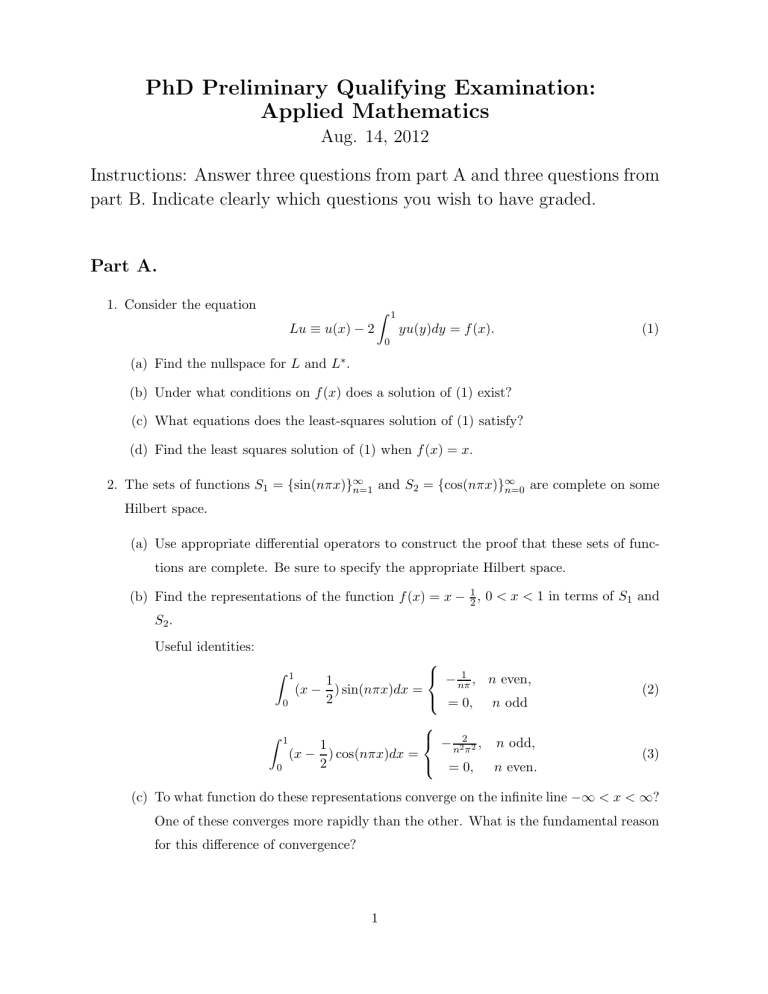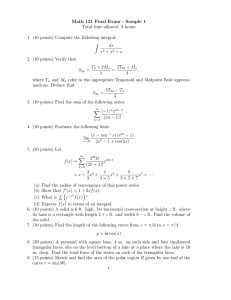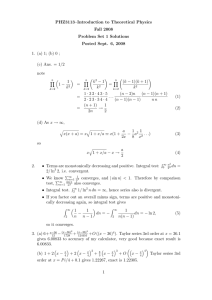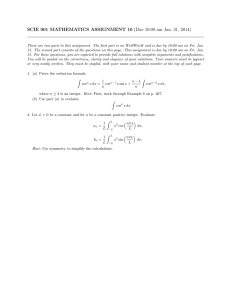PhD Preliminary Qualifying Examination: Applied Mathematics

PhD Preliminary Qualifying Examination:
Applied Mathematics
Aug. 14, 2012
Instructions: Answer three questions from part A and three questions from part B. Indicate clearly which questions you wish to have graded.
Part A.
1. Consider the equation
Lu ≡ u ( x ) − 2
Z
1
0 yu ( y ) dy = f ( x ) .
(a) Find the nullspace for L and L ∗ .
(b) Under what conditions on f ( x ) does a solution of (1) exist?
(c) What equations does the least-squares solution of (1) satisfy?
(d) Find the least squares solution of (1) when f ( x ) = x .
(1)
2. The sets of functions S
1
= { sin( nπx ) } ∞ n =1 and S
2
= { cos( nπx ) } ∞ n =0 are complete on some
Hilbert space.
(a) Use appropriate differential operators to construct the proof that these sets of functions are complete. Be sure to specify the appropriate Hilbert space.
(b) Find the representations of the function f ( x ) = x − 1
2
, 0 < x < 1 in terms of S
1 and
S
2
.
Useful identities:
Z
1
( x −
0
1
2
) sin( nπx ) dx =
− 1 nπ
, n even ,
= 0 , n odd
(2)
Z
1
( x −
0
1
2
) cos( nπx ) dx =
− 2 n 2 π 2
, n odd ,
= 0 , n even .
(3)
(c) To what function do these representations converge on the infinite line −∞ < x < ∞ ?
One of these converges more rapidly than the other. What is the fundamental reason for this difference of convergence?
1
3. Using a Green’s function, find an integral representation of the solution u ( x ) to d 2 u
− u = dx 2
1
1 + x 2
, u ( − 1) = u (1) = 0 x ∈ [ − 1 , 1] (do not evaluate the integral).
4. (a) Specify the weak formulation for the differential equation u ′′ + λδ ( x ) u = 0 subject to boundary conditions u ( − 1) = u (1) = 0.
(b) Find all values of λ for which this differential equation has a nontrivial solution and verify that the corresponding solution is a weak solution.
5. Suppose the matrix A = ( a ij
) has non-negative entries and that P j a ij
= 1.
(a) Show that A has an eigenvalue λ = 1.
(b) Suppose all of the eigenvalues of A are simple. Prove that the eigenvector of A corresponding to eigenvalue λ = 1 has only non-negative entries. Prove that the non-negative eigenvector is unique, i.e., all other eigenvectors must have entries with differing signs.
(c) Prove that the iteration x n
= Ax n − 1 converges to the non-negative eigenvector of A .
2
Part B.
1. (a) Formulate and derive the argument principle [which determines the difference between the number of zeros ( N
0
) and poles ( N
∞
) of an analytic function f ( z )].
(b) Applying this principle, determine the number of zeros located inside the first quadrant { z = x + iy : x > 0 , y > 0 } of the function f ( z ) = z 5 + 1.
2. Find the image of the half-strip { z = x + iy : x > 0 , 0 < y < 1 } under the mapping w = 1 /z .
3. Calculate the integral
I =
Z ∞
0 x α
1 + x dx where α is a real number for which the integral converges.
4. Formulate and derive the uncertainty principle . Is its inequality optimal?
5. Find at least three terms of the asymptotic expansion of the integral
I ( s ) =
Z
1 ln t e ist
0 dt, s is real and s → + ∞ .
3




